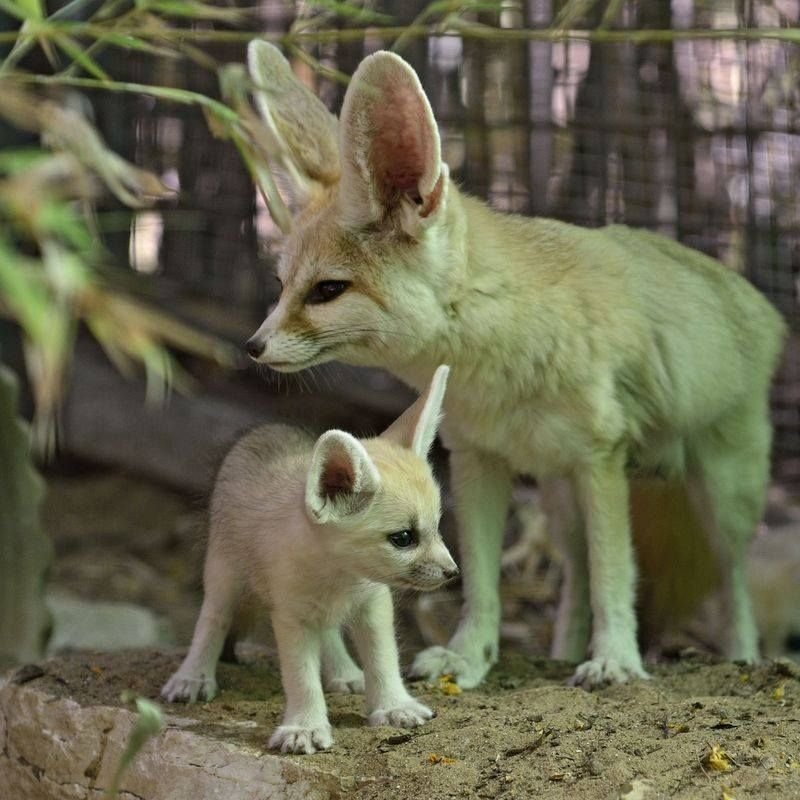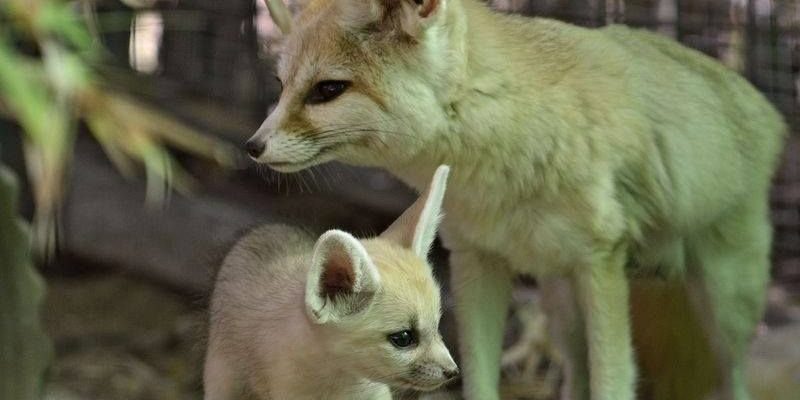
Imagine being a parent in the middle of a vast, hot desert. You’ve got to protect your little ones from predators, keep them cool during the day, and teach them how to find food when they’re older. That’s the daily life for a fennec fox mom and dad. They work together to ensure that their kits not only survive but grow up to be clever and resourceful, just like them.
So, let’s dive into the unique world of fennec fox parenting and explore how they raise their young in the wild.
Fennec Fox Education: Preparing for Life
Fennec fox kits are born after a gestation period of about 50 to 52 days. They come into the world blind and helpless, relying entirely on their parents for every need. These little furballs are usually born in litters of 2 to 5, and their early days are all about nurturing. You might be wondering how the parents manage this demanding task in such a harsh environment.
Strong Family Bonds
Fennec foxes are social animals, often living in small family groups. Both parents take an active role in raising their young. The mother typically stays with the kits in their burrow, keeping them safe from the desert heat and any potential threats. Meanwhile, the father hunts and brings food back for the family. It’s a team effort, with both parents ensuring their kits get the love and nourishment they need.
Learning Through Play
Once the kits are old enough to leave the burrow, playtime becomes crucial. These playful moments are not just fun; they’re essential for teaching important skills. The kits chase each other, wrestle, and explore their surroundings. Through play, they learn how to hunt, defend themselves, and interact with others. Honestly, it’s like a little fennec fox kindergarten, where they pick up all the tricks they’ll need to thrive in the wild.
Building a Safe Home: Their Unique Burrows
One of the most interesting aspects of fennec fox parenting is their burrow-building skills. The burrows serve as nests and protection for the kits. But how do they create such safe spaces in a vast desert?
Complex Architecture
Fennec foxes use their strong claws to dig deep burrows that can be up to 10 feet long. These tunnels have multiple entrances, allowing the family to escape easily if they sense danger. The burrow also helps regulate temperature, keeping the kits cool during the day and warm at night. Here’s the thing: a well-constructed home is vital for survival in the harsh desert climate.
Location Matters
The location of the burrow is critical. Fennec foxes often choose sandy areas with plenty of cover to hide from predators like snakes or larger mammals. This strategic choice not only protects their young but also provides a safe place for the parents to hunt nearby. It’s all about balancing safety and accessibility.
Feeding the Family: The Parent’s Role
In the wild, finding food isn’t always easy. Fennec foxes primarily eat insects, small mammals, and fruits, depending on what’s available. So, how do the parents ensure their kits are well-fed?
Foraging Together
Once the kits are old enough to accompany their parents, they join in the foraging process. The parents take them to different hunting spots, showing them how to find food. You might think of this as the ultimate family outing — a blend of adventure and life lessons all rolled into one.
Hunting Techniques
Fennec foxes use their extraordinary hearing to locate food buried beneath the sand. They’ll often dig or hop to catch their prey. By teaching their kits these techniques, the parents equip them with essential skills they’ll need as they grow older. It’s a beautiful way of passing down knowledge and ensuring that the next generation can fend for themselves.
Protective Instincts: Watching Over the Young
Parenting in the wild comes with its dangers. Predators can pose a significant threat to fennec fox kits. So, how do fennec foxes protect their young from harm?
Vigilant Guardianship
Both parents remain vigilant when it comes to watching over their kits. If they sense danger, they’ll use a range of warning signals to alert one another. This might be a bark or a specific position, letting the other parent know it’s time to get the kits to safety. You might be surprised at how synchronized they are — almost like a well-rehearsed dance.
Camouflage and Stealth
Kits are born with fur that blends in beautifully with their sandy surroundings. This natural camouflage helps keep them safe during their vulnerable stages. As they grow and learn, their parents teach them how to use this adaptation to stay hidden from birds of prey or other potential threats.
Growing Up: Independence and Leaving the Nest
As the kits grow, they start to develop their personalities and skills. But when is it time for them to venture out on their own?
The Transition to Independence
Fennec fox kits usually stay with their family for about 6 months. During this time, they learn everything they need to know to survive. The parents gradually encourage independence by allowing the kits to hunt small prey on their own. It’s like a gradual nudge into the world, pushing them to explore and try new things.
Leaving the Family
Eventually, the young fennec foxes will leave to find their own territories. This moment can be bittersweet. The parents have invested a lot of time and effort into raising their kids, but it’s also a proud moment. They’ve given their kits the tools they need to thrive in the wild. It’s like watching your child take their first steps into adulthood.
In many ways, the way fennec foxes raise their young mirrors our own experiences. There’s love, care, hard work, and a lot of teaching involved. These remarkable creatures adapt their parenting strategies to fit their harsh desert environment, ensuring their kits can thrive.
By observing the fennec fox and their nurturing ways, we gain insight into the beauty of nature and the complexities of life. The cycle of life continues, and as these little foxes grow, they carry on the legacy of their parents. It’s a wonderful reminder that, whether in the wild or at home, parenting is about preparing the next generation to thrive in the world.

